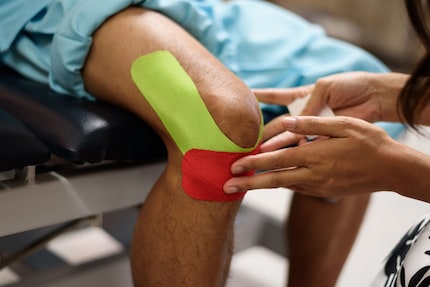
Background information
Why a running analysis was worthwhile for me – and might be something for you too
by Siri Schubert

Many joggers struggle with injuries. Until now, conventional wisdom was that runners could reduce their risk of getting hurt if they increased their mileage by no more than ten per cent per week. A researcher from Denmark has now disproved this. In this interview, he reveals what’ll really help you stay injury-free.
«Don’t increase your distance by more than ten per cent from one week to the next.» In running circles, this advice has been repeated so often that it’s almost become a mantra. Not only that, but it’s also found its way into the algorithms of running watches – and formed the basis of numerous workout plans available online.

According to new research, however, the ten-per-cent rule is incorrect. Rasmus Østergaard Nielsen, Associate Professor at Aarhus University in Denmark, and his team collected data from 5,205 runners across 87 countries over an 18-month period as part of the Garmin Runsafe Health Study. Participants logged almost 600,000 running sessions, with 35 per cent of them sustaining an overuse injury during the study.
The research project – the largest of its kind to date – demonstrates that running-related overuse injuries occur suddenly – not gradually, as previously assumed. Sometimes, they even happen during a single workout. I interviewed the study’s lead researcher.
Many runners (myself included) use the ten-per-cent rule to build up their mileage. Have we been getting this completely wrong?
You could say that. Over the course of our study, we found that even a single training session involving too great a distance significantly increased the risk of injury.
What does that mean in practice?
If you run 11–13 kilometres instead of your usual ten, your risk of injury will be 64 per cent higher. If you double your mileage, i.e. suddenly run 20 kilometres instead of ten, that risk increases by 128 per cent.
What kind of injury are we talking about here?
Overuse injuries, mostly involving the tendons. Typical ones include runner’s knee, jumper’s knee, kneecap pain, discomfort on the inside of the lower leg, and tibial plateau syndrome. If you increase your training intensity too quickly and run too many tough intervals, you’ll be more likely to experience inflammation of the Achilles tendon, posterior thigh injuries or plantar fasciitis (plantar heel pain).

Over the course of your study, 35 per cent of participating runners sustained overuse injuries. And that’s despite the fact that jogging’s generally considered to be healthy, and by no means a risky sport.
What many people don’t realise is that running injuries can have serious consequences. They leave you out of action for months, unable to work out – or only able to do so to a very limited extent. Some suffer from the consequences of the damage for the rest of their lives.
What makes running injuries so insidious?
Overuse injuries are underestimated, but they’re every bit as serious as traumatic injuries. The thing that makes them unique is how long they take to heal. If tendons are damaged as a result of excessive, repeated strain, we’re talking three to eight months. However, some injuries never heal completely.

If overuse injuries are so common and the ten-per-cent rule doesn’t offer any protection, why’s it so widespread?
For several decades, clinical textbooks, coaches, physiotherapists and the smartwatch industry have relied on the idea that overuse injuries develop gradually over time. As a result, science has focused on the question of how mileage should increase from week to week. This gave rise to the ten-per-cent rule, which stipulates you should increase your weekly running distance by a maximum of 10 per cent – the idea being that you make progress without putting yourself at too great a risk of injury.
Many sports watches’ algorithms are based on this same rule to make sure that people safely increase their mileage. Are you saying that doesn’t actually protect runners?
The algorithms behind some sports watches and generic internet training plans actually recommend 20 per cent. However, in 15 years of studying running injuries from a scientific perspective, we haven’t identified any consistent patterns that confirm that approach. Quite the opposite, in fact. The number of runners sustaining injuries has remained high.
What would you advise instead?
You should increase your distance by small increments. I think a five-per-cent rule provides better protection. If you’re training for a marathon, for instance, you should give yourself plenty of time to do so and increase your mileage slowly. Runners who’re just starting out would probably need a year and a half to safely work their way up to a marathon. Of course, some individuals might be able to do it faster, but there’s a risk associated with that.
How long should your longest marathon prep run be? People often say it should be 30 kilometres, but I assume that’s wrong.
When training for a marathon, I’d try to hit 39 kilometres rather than the longest distance. This reduces your risk of injury during the race itself.
There’s a trend on Instagram and TikTok at the moment, where people supposedly run a marathon based purely on mental strength. In other words, they don’t do any preparation. I’m guessing that’s not a good idea.
Of course, that’s possible from a mental point of view, but every body reaches its limits eventually. The question is where those limits are. It really depends on what type of runner you are, but one thing’s for certain: nobody’s a superhero who can just keep going. Everyone collapses at some point.
Are there any factors that influence the risk of injury?
To name a few examples, runners are more likely to sustain an injury if they wear a new type of shoe, change terrain or running speed or run too much. If the distance and intensity suddenly change, other structures have to compensate. The problem is, they need time to adapt.
What else can have an impact?
Previous injuries, because they linger as vulnerabilities. If you’re older and have already had a number of minor injuries, you probably won’t be able to tolerate excessive strain either. Another factor is body mass index (BMI). Heavier runners are at higher risk and should be even more careful when increasing their mileage.

Will manufacturers adapt their sports watches to take your research results into account any time soon?
I hope so. Although Garmin gave us a lot of support in recruiting participants for the study, they didn’t have any influence over the work or results. I’d obviously welcome it if they incorporated our results into their algorithms – not just Garmin, but other manufacturers too. We’ve made the results available to everyone. We personally don’t have any commercial interests; as researchers, we’re focused on promoting health.
What’s next for you?
The results of our study definitely made us curious about whether the same conclusion applies to other sports. If someone usually does 50 squats during a workout but then, encouraged by a personal trainer or a fitness challenge, does 500 squats, I suspect that’d increase the risk of injury. I think it involves exactly the same problem as running. We’d like to look into this so that we can have the data and see whether we can prove that assumption.
Rasmus, thank you very much for the interview and interesting insights into your research.
Research diver, outdoor guide and SUP instructor – I love being in, on and around water. Lakes, rivers and the ocean are my playgrounds. For a change of perspective, I look at the world from above while trail running or flying drones.
Interesting facts about products, behind-the-scenes looks at manufacturers and deep-dives on interesting people.
Show all
Background information
by Siri Schubert

Background information
by Anna Sandner

Background information
by Siri Schubert